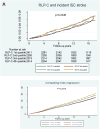Remnant-Like Particle Cholesterol, Low-Density Lipoprotein Triglycerides, and Incident Cardiovascular Disease
- PMID: 29976289
- PMCID: PMC6051722
- DOI: 10.1016/j.jacc.2018.04.050
Remnant-Like Particle Cholesterol, Low-Density Lipoprotein Triglycerides, and Incident Cardiovascular Disease
Abstract
Background: Hypertriglyceridemia is associated with increased remnant-like particle cholesterol (RLP-C) and triglycerides in low-density lipoprotein (LDL-TG). Recent studies have focused on atherogenicity of RLP-C, with few data on LDL-TG.
Objectives: The aim of this study was to examine associations of RLP-C and LDL-TG with incident cardiovascular disease (CVD) events and genetic variants in the ARIC (Atherosclerosis Risk In Communities) study.
Methods: Fasting plasma RLP-C and LDL-TG levels were measured in 9,334 men and women without prevalent CVD. Participants were followed for incident CVD events (coronary heart disease and ischemic stroke) for up to 16 years. Associations between LDL-TG and RLP-C levels and genetic variants were assessed by whole-exome sequencing using single-variant analysis for common variants and gene-based burden tests for rare variants; both an unbiased and a candidate gene approach were explored.
Results: RLP-C and LDL-TG levels were correlated with triglyceride levels (r = 0.85 and r = 0.64, p < 0.0001). In minimally adjusted analyses, RLP-C and LDL-TG were associated with CVD risk, but in models adjusted for traditional risk factors including lipids, only LDL-TG was associated with incident CHD (hazard ratio: 1.28; 95% confidence interval: 1.10 to 1.50) and stroke (hazard ratio: 1.47; 95% confidence interval: 1.13 to 1.92). A common APOE variant, rs7412, had the strongest association with LDL-TG and RLP-C (p < 5 × 10-8).
Conclusions: RLP-C and LDL-TG levels were predictive of CVD and associated with APOE variants. LDL-TG may represent a marker of dysfunctional remnant lipoprotein metabolism associated with increased CVD risk. Further research is needed to determine whether LDL-TG plays a causal role in CVD and may be a target for therapy.
Keywords: coronary heart disease; remnant lipoproteins; risk; stroke; triglyceride-rich lipoproteins.
Copyright © 2018 American College of Cardiology Foundation. Published by Elsevier Inc. All rights reserved.
Figures







Comment in
-
Low-Density Lipoprotein Triglycerides: Widening the Atherogenic Landscape in CVD Risk Assessment.J Am Coll Cardiol. 2018 Jul 10;72(2):170-172. doi: 10.1016/j.jacc.2018.03.541. J Am Coll Cardiol. 2018. PMID: 29976290 No abstract available.
References
-
- Sarwar N, Danesh J, Eiriksdottir G, et al. Triglycerides and the risk of coronary heart disease: 10,158 incident cases among 262,525 participants in 29 Western prospective studies. Circulation. 2007;115:450–8. - PubMed
-
- Austin MA, Hokanson JE, Edwards KL. Hypertriglyceridemia as a cardiovascular risk factor. Am J Cardiol. 1998;81:7b–12b. - PubMed
-
- Boullart AC, de Graaf J, Stalenhoef AF. Serum triglycerides and risk of cardiovascular disease. Biochim Biophys Acta. 2012;1821:867–75. - PubMed
Publication types
MeSH terms
Substances
Grants and funding
LinkOut - more resources
Full Text Sources
Other Literature Sources
Medical
Miscellaneous

